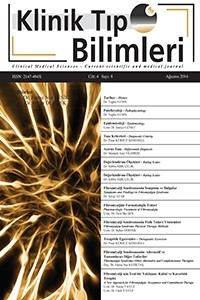Gestasyonel Diyabet Tanı ve Tedavisi
Gestasyonel diyabet, riskfaktörleri, tarama, oral glikoz tolerans testi, tedaviyönetimi
Gestational Diabetes Mellutus: Diagnosis and Treatment
Gestational diabetes, riskfactors, oral glucose tolerance test, management,
___
- Kaynaklar 1. American Diabetes Association. Classification and Diagnosis of Dia-betes. Diabetes Care 2017; 40(Suppl. 1):S11–S24 | DOI:10.2337/dc17-S005 2. World Health Organization. Diagnostic Criteria and Classification ofHyperglycaemia First Detected in Pregnancy. Diagnostic Criteriaand Classification of Hyperglycaemia First Detected in Pregnancy.August 2013 http://www.who.int/diabetes/publications/Hypergly-caemia_In_Pregnancy/en/index.html 3. Diabetes Mellitus ve Komplikasyonlarının Tanı, Tedavi ve İzlem Kı-lavuzu. TEMD Diabetes Mellitus Çalışma ve Eğitim Grubu; 2016 4. Committee on Practice Bulletins--Obstetrics. Practice Bulletin No. 137:Gestational diabetes mellitus. Obstet Gynecol 2013; 122:406. 5. International Association of Diabetes and Pregnancy Study GroupsConsensus Panel, Metzger BE, Gabbe SG, et al. International asso-ciation of diabetes and pregnancy study groups recommendations onthe diagnosis and classification of hyperglycemia in pregnancy. Dia-betes Care 2010; 33:676. 6. Hod M, Kapur A, Sacks DA, et al. The International Federation of Gyne-cology and Obstetrics (FIGO) Initiative on gestational diabetes mel-litus: A pragmatic guide for diagnosis, management, and care. IntJ Gynaecol Obstet 2015; 131 Suppl 3:S173. 7. Moyer VA, U.S. Preventive Services Task Force. Screening for gesta-tional diabetes mellitus: U.S. Preventive Services Task Force recom-mendation statement. Ann Intern Med 2014; 160:414. 8. Guariguata L, Linnenkamp U, Beagley J, et al. Global estimates of theprevalence of hyperglycaemia in pregnancy. Diabetes Res Clin Pract2014; 103:176 9. O'Sullivan JB, Mahan CM. Criteria for the oral glucose tolerance testin pregnancy. Diabetes 1964; 13:278-285 10. HAPO Study Cooperative Research Group. Hyperglycemia and ad-verse pregnancy outcomes. New England Journal of Medicine2008; 358(19):1991-2002 11. Landon MB, Mele L, Spong CY, et al. The relationship between ma-ternal glycemia and perinatal outcome. Obstet Gynecol 2011;117:218. 12. Farrar D, Simmonds M, Bryant M, et al. Hyperglycaemia and riskof adverse perinatal outcomes: systematic review and meta-analy-sis. BMJ 2016; 354:i4694. 13. Cheng YW, Chung JH, Kurbisch-Block I, et al. Gestational weightgain and gestational diabetes mellitus: perinatal outcomes. ObstetGynecol. 2008 Nov. 112(5):1015-22 14. Yogev Y, Langer O. Pregnancy outcome in obese and morbidly obe-se gestational diabetic women. Eur J Obstet Gynecol Reprod Biol.2008 Mar. 137(1):21-6 15. McFarland MB, Trylovich CG, Langer O. Anthropometric differen-ces in macrosomic infants of diabetic and nondiabetic mothers. J Ma-tern Fetal Med. 1998 Nov-Dec. 7(6):292-5 16. Patel S, Fraser A, Davey Smith G, et al. Associations of gestationaldiabetes, existing diabetes, and glycosuria with offspring obesity andcardiometabolic outcomes. Diabetes Care. 2012 Jan. 35(1):63-71 17. Hillier TA, Pedula KL, Schmidt MM, et al. Childhood obesity and me-tabolic imprinting: the ongoing effects of maternal hyperglycemia.Diabetes Care 2007; 30:2287 18. West NA, Crume TL, Maligie MA, Dabelea D. Cardiovascular riskfactors in children exposed to maternal diabetes in utero. Diabeto-logia. 2011 Mar. 54(3):504-7. 19. Nomura Y, Marks DJ, Grossman B, Yoon M, Loudon H, Stone J, Hal-perin JM. Exposure to gestational diabetes mellitus and low soci-oeconomic status: effects on neurocognitive development and risk ofattention-deficit/hyperactivity disorder in offspring. Arch Pediatr Ado-lesc Med. 2012 Apr;166(4):337-43. 20. Stuebe AM, Mantzoros C, Kleinman K, et al. Gestational glucose to-lerance and maternal metabolic profile at 3 years postpartum. Obs-tet Gynecol. 2011 Nov. 118(5):1065-73 21. Benhalima K, Jegers K, Devlieger R, Verhaeghe J, Mathieu C. Glu-cose Intolerance after a Recent History of Gestational Diabetes Ba-sed on the 2013 WHO Criteria. PLoS One. 2016. 11 (6):e0157272 22. Moses R, Griffiths R, Davis W. Gestational diabetes: do all womenneed to be tested?. Aust N Z J Obstet Gynaecol. 1995 Nov.35(4):387-9. 23. Coustan DR. (2017) Diabetes mellitus in pregnancy: Screening anddiagnosis. In VA Barss(Ed). UpToDate. 24. Hartling L, Dryden DM, Guthrie A, Muise M, Vandermeer B, Do-novan L. Benefits and harms of treating gestational diabetes melli-tus: a systematic review and meta-analysis for the U.S. PreventiveServices Task Force and the National Institutes of Health Office ofMedical Applications of Research. Ann Intern Med 2013;159:123–129 25. Hebert MF, Ma X, Naraharisetti SB, et al.; Obstetric-Fetal Pharma-cology Research Unit Network. Are we optimizing gestational dia-betes treatment with glyburide? The pharmacologic basis for betterclinical practice. Clin Pharmacol Ther 2009;85:607–614 31. 26. Balsells M, Garc´ıa-Patterson A, Sol`a I, Roqu´e M, Gich I, CorcoyR. Glibenclamide, metformin, and insulin for the treatment of gesta-tional diabetes:a systematic review and meta-analysis.BMJ2015;350:h102. 27. Rowan JA, Hague WM, Gao W, Battin MR, Moore MP; MiG TrialInvestigators. Metformin versus insulin for the treatment of gesta-tional diabetes. N Engl J Med 2008;358:2003–2015 27 28. Vanky E, Zahlsen K, Spigset O, Carlsen SM. Placental passage ofmetformin in women with polycystic ovary syndrome. Fertil Steril2005;83: 1575–1578 35. 29. Charles B, Norris R, Xiao X, Hague W. Population pharmacokine-tics of metformin in latepregnancy. Ther Drug Monit 2006;28:67–72 30. Vanky E, Stridsklev S, Heimstad R, et al. Metformin versus placebofrom first trimester to delivery in polycystic ovary syndrome: a ran-domized, controlled multicenter study. J Clin Endocrinol Metab2010;95:E448–E455. 31. American Diabetes Association. Management of Diabetes in Preg-nancy. Diabetes Care. 2017 Jan;40(Suppl 1):S114-S119. 32. Gui J, Liu Q, Feng L. Metformin vs insulin in the management of ge-stational diabetes: a meta-analysis. PLoS One 2013;8:e64585. 33. Langer O, Conway DL, Berkus MD, Xenakis EM, Gonzales O. A com-parison of glyburide and insulin in women with gestational diabe-tes mellitus. N Engl J Med 2000;343:1134–1138. 34. Stuebe AM, Rich-Edwards JW, Willett WC, Manson JE, Michels KB.Duration of lactation and incidence of type 2 diabetes. JAMA 2005;294:2601–2610. 35. Pereira PF, Alfenas R de C, Ara ´ ujo RM. Does breastfeeding in-fluence the risk of developing diabetes mellitus in children? A revi-ew of current evidence. J Pediatr (Rio J) 2014;90:7–15.
- ISSN: 2147-494X
- Başlangıç: 2013
- Yayıncı: Selen Medya Yayıncılık Tanıtım ve Organizasyon Hizmetleri
Tip 2 Diyabet Tedavisinde Bariyatrik Cerrahinin Yeri
Yetişkin ve Çocuklarda Diyabet İğne Uçları Kullanımı
Tıbbi Beslenme Tedavisinde Karbonhidrat Sayımının Yeri
Diyabetik Nefropatide Tedavi Yaklaşımları
Tip 2 Diyabetin Oral Antidiyabetik İlaçlarla Tedavisi
Obez Diyabetik Bireylerin Tıbbi BeslenmeTedavisi Planlarında Yağ ve Protein
Gestasyonel Diyabet Tanı ve Tedavisi
